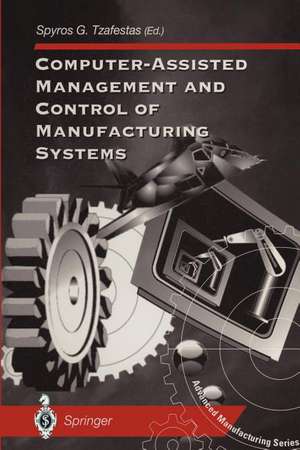Computer-Assisted Management and Control of Manufacturing Systems: Advanced Manufacturing
Editat de Spyros G. Tzafestasen Limba Engleză Paperback – 17 sep 2011
Din seria Advanced Manufacturing
- 15%
 Preț: 645.79 lei
Preț: 645.79 lei - 15%
 Preț: 649.06 lei
Preț: 649.06 lei - 15%
 Preț: 636.45 lei
Preț: 636.45 lei - 15%
 Preț: 647.92 lei
Preț: 647.92 lei -
 Preț: 387.38 lei
Preț: 387.38 lei - 15%
 Preț: 635.65 lei
Preț: 635.65 lei -
 Preț: 390.84 lei
Preț: 390.84 lei -
 Preț: 384.86 lei
Preț: 384.86 lei -
 Preț: 388.13 lei
Preț: 388.13 lei - 15%
 Preț: 646.43 lei
Preț: 646.43 lei - 15%
 Preț: 693.06 lei
Preț: 693.06 lei -
 Preț: 385.08 lei
Preț: 385.08 lei -
 Preț: 388.52 lei
Preț: 388.52 lei - 18%
 Preț: 943.73 lei
Preț: 943.73 lei - 15%
 Preț: 586.85 lei
Preț: 586.85 lei - 15%
 Preț: 652.81 lei
Preț: 652.81 lei
Preț: 650.69 lei
Preț vechi: 765.51 lei
-15% Nou
Puncte Express: 976
Preț estimativ în valută:
124.53€ • 128.91$ • 105.25£
124.53€ • 128.91$ • 105.25£
Carte tipărită la comandă
Livrare economică 05-19 martie
Preluare comenzi: 021 569.72.76
Specificații
ISBN-13: 9781447112426
ISBN-10: 1447112423
Pagini: 508
Ilustrații: XX, 483 p.
Dimensiuni: 155 x 235 x 27 mm
Greutate: 0.7 kg
Ediția:Softcover reprint of the original 1st ed. 1997
Editura: SPRINGER LONDON
Colecția Springer
Seria Advanced Manufacturing
Locul publicării:London, United Kingdom
ISBN-10: 1447112423
Pagini: 508
Ilustrații: XX, 483 p.
Dimensiuni: 155 x 235 x 27 mm
Greutate: 0.7 kg
Ediția:Softcover reprint of the original 1st ed. 1997
Editura: SPRINGER LONDON
Colecția Springer
Seria Advanced Manufacturing
Locul publicării:London, United Kingdom
Public țintă
ResearchCuprins
1 Modern Manufacturing Systems: An Information Technology Perspective.- 1 Introduction.- 2 Basic engineering CIM functions.- 3 Information technology enhances the competitive advantage.- 4 An intra-organizational CIM model.- 5 An inter-organizational CIM model.- 6 Artificial intelligence in CIM systems.- 7 Economic evaluation of automated manufacturing.- 8 Conclusions.- References.- 2 Decision Support Systems in Manufacturing Systems Managemen.- 1 Introduction.- 2 DSS in general.- 3 Problem domains.- 4 Problem solving strategy.- 5 DSS for operation scheduling and dispatching.- 6 DSS for process planning.- 7 Conclusions.- References.- 3 AI in Manufacturing: Application to FM S Simulation, Scheduling and Control.- 1 Introduction.- 2 Important issues in application of AI manufacturing.- 3 Knowledge based simulation, evaluation, scheduling, quality control and real-time control of manufacturing systems.- 4 Conclusions.- References.- 4 Modelling and Analyzing Processes in Production and Administration.- 1 Motivation.- 2 ProMAX requirements.- 3 ProMAX architecture and environment.- 4 Impacts on software engineering.- 5 Applications in administration.- 6 Applications in production.- 7 Conclusions.- References.- 5 Quality Management in CIM.- 1 Introduction.- 2 Quality management in information system.- 3 Quality management in production control.- 4 Communication support for quality asssurance.- 5 Product based quality management and manufacturing control.- 6 Conclusions.- References.- 6 Best Practice in Shop Floor Schedulin.- 1 Introduction.- 2 The dominance of MRP and MRPII.- 3 Modern scheduling approaches.- 4 Research method.- 5 Assessment of planning and scheduling performance.- 6 Classification of planning and scheduling.- 7 Analysis of results.- 8 Conclusions.- References.- 7 A Stable, Distributed Routing Policy for Flexible Manufacturing Systems.- 1 Introduction.- 2 Lyapunov stability of DEDS.- 3 Part type routing policy.- 4 Simulation example.- 5 Conclusion.- References.- 8 Shop Controllers-Managers for Intelligent Manufacturing.- 1 Introduction.- 2 Efficiency through economy of scope.- 3 Govern-for-flexibility knowledge architecture.- 4 Applications and example development.- 5 Concluding comments.- References.- 9 A CIM Designed According to Ward and Mello.- 1 The Ward and Mellor methodology.- 2 The Ward and Mellor methodology applied to CIM.- 3 Evaluation of the Ward and Mellor methodology.- 4 Conclusions.- References.- 10 Monitoring and Automatic Supervision in Manufacturing Systems.- 1 Introduction.- 2 Classification of disturbances.- 3 Sensors and methods of monitoring.- 4 Methods of influencing manufacturing systems.- 5 Automatic supervisory systems.- 6 Conclusions.- References.- 11 Petri Nets for Designing Manufacturing System.- 1 Introduction.- 2 Petri nets.- 3 Modeling FMS using Petri nets.- 4 Validation of Petri net models.- 5 Coordination control of production systems by mean of Petri nets.- 6 Design, modelling and analysis of a FMS.- 7 Conclusions.- References.- 12 Petri Net-Based Approach to Synthesis of Intelligent Control Systems for DEDS.- 1 Introduction.- 2 Petri net-based modelling of DEDS.- 3 Analysis of the DEDS control possibilities.- 4 Petri nets in the rule-based knowledge representation.- 5 Utilizing the knowledge base in the control synthesis.- 6 Illustrative examples.- 7 Knowledge inference and automatic reasoning.- 8 An illustrative example.- 9 Conclusions.- References.- 13 New Methods and Tools for Commissioning of Manufacturing Lines with Robots.- 1 Introduction.- 2 State-of-the-art in robot planning and future needs.- 3 Methods and tools for commissioning time reduction.- 4 Conclusions.- References.- 14 Balanced Automation.- 1 Introduction.- 2 Difficulties and contributions.- 3 BAS and shop floor.- 4 BAS and scheduling.- 5 BAS and concurrent engineering.- 6 BAS and virtual enterprises.- 7 Conclusions.- References.- 15 Factory Principles Applied to Analytical Chemistry: An Integrated Laboratory Management System.- 1 Introduction.- 2 Business motives.- 3 Business integration.- 4 Laboratory integration.- 5 Anatomy of the ILMS.- 6 The integration process.- 7 The experience.- References.- 16 The Generalized Network Model: Algorithms and Application to Manufacturing Operations.- 1 Introduction.- 2 Network formulation and mathematical problem statement.- 3 Solution algorithms.- 4 Applications.- 5 Genet-optimizer and Genetexp: A new GN-modelling tool.- 6 Conclusions.- References.- Biographies of the Contributors.










